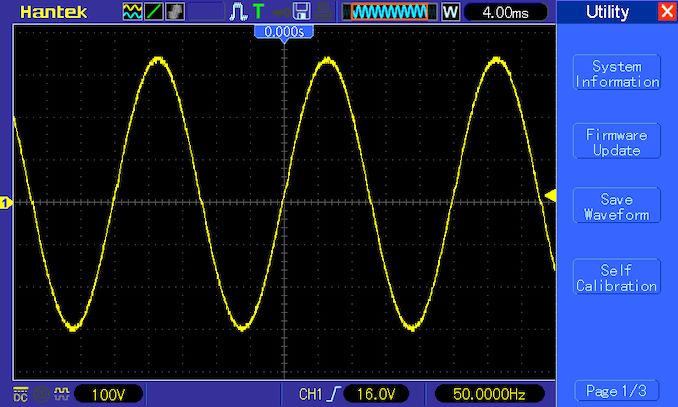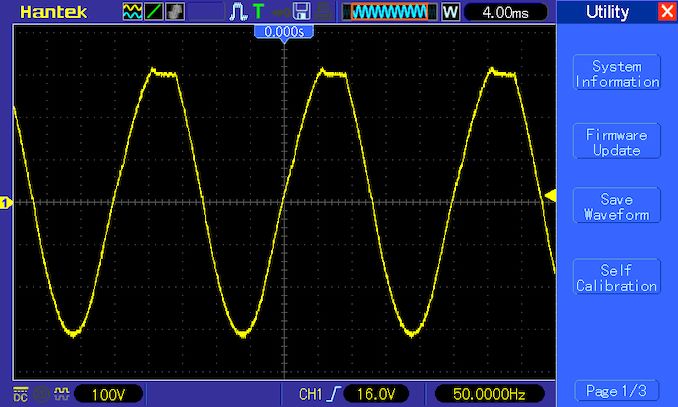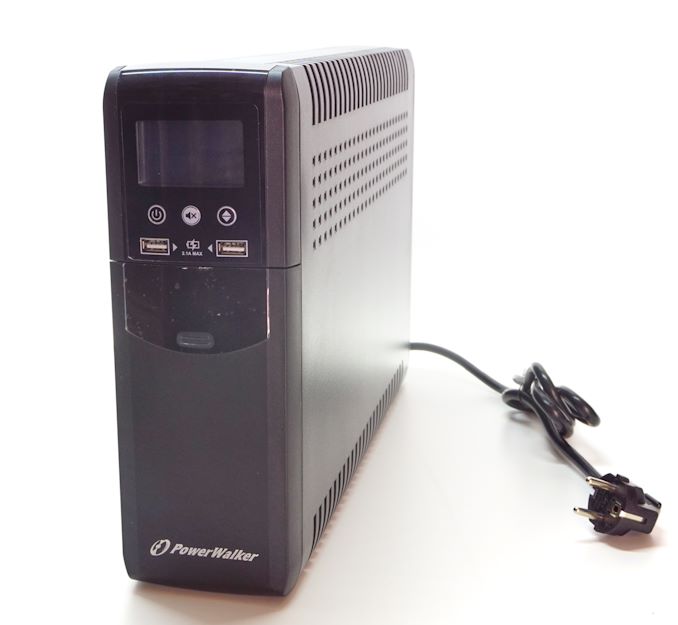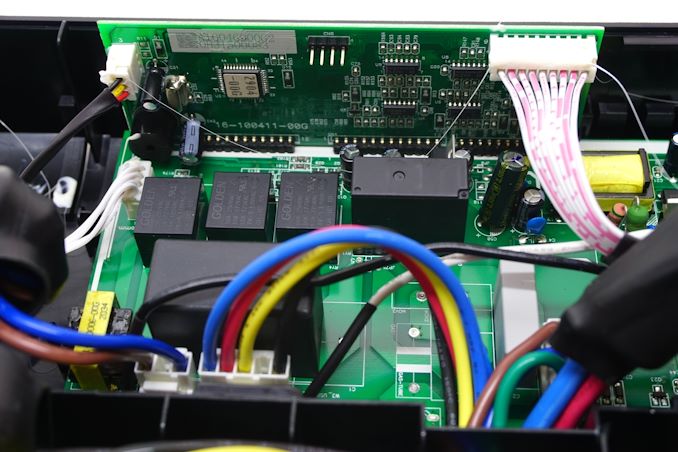The PowerWalker VI 1500 CSW UPS Review: Trying For True Sinewave on a Budget
by E. Fylladitakis on April 13, 2022 8:00 AM EST- Posted in
- Cases/Cooling/PSUs
- UPS
- PowerWalker
- BlueWalker
- 1500VA
Testing
Putting the PowerWalker VI 1500 CSW to the test, the basic electrical figures of the UPS are acceptable, with the unit delivering the performance it promises. When it operates on battery power, the voltage output is exactly 224 V RMS regardless of the load. There are minor frequency variations but these are exceptionally small. The transfer time is relatively high, yet not out of the manufacturer’s specifications. Though it also seems to significantly depend on the load, which should not be happening to this extent.
| UPS Load Performance | |||||
| 10% | 25% | 50% | 75% | 100% | |
| Voltage Output (Vrms) | 224 | 224 | 224 | 224 | 224 |
| Frequency (Hz) | 50.05 | 50 | 50 | 49.95 | 50 |
| Transfer Time (ms) | 6.1 | 7.6 | 7.8 | 7.6 | 8.9 |
The fan of the unit outputs 41.6 dB(A) once it is running. By UPS standards this is not a very high figure, but it's certainly not a very comfortable amount of noise, either. The downside here is that the PowerWalker VI 1500 CSW requires nearly 10 hours to fully charge its batteries once they are completely empty, which could be a problem with the unit installed in a living room or, worse, bedroom.
In our load testing, we've found that the battery runtime of the PowerWalker VI 1500 CSW is even better than advertised. These figures are achieved with its batteries fully charged and while they are new.
The PowerWalker VI 1500 CSW boasts true sinewave output, and our testing confirms this. Under load, our instruments showing a nearly-perfect sine wave with the unit running on battery power – but only while the load is low. Once the load reaches 50% (450 Watts) the deformation of the sine wave becomes apparent. It also becomes deformed abnormally, with only the positive peaks getting chopped, meaning that it is only one half of the circuitry failing to perform. At nearly 90% load (800 Watts) the waveform is nearly square, with both peaks heavily chopped, suggesting a massive number of harmonics. This will definitely not be healthy for any device that requires a pure sinewave input, such as APFC circuitry and AC motors.
Conclusion
The PowerWalker VI 1500 CSW is a UPS designed to combine a high output and true sinewave capability at a retail price affordable for most home consumers. At around €180, it currently retails for half of the price reputable manufacturers ask for their equally powerful true sinewave products, making it a very enticing deal.
The build quality of the PowerWalker VI 1500 CSW is better than one would expect from a product retailing at this price. Its parts are coming from reputable manufacturers and the unit is very well assembled. The design is dated but that is not inherently wrong – it just means the unit isn't geared to deliver the kind of top-of-the-line performance that more recent designs can provide.
When it comes to performance, the PowerWalker VI 1500 CSW performs, for the most part, according to its specifications. The trade-offs and issues become apparent when a closer look is taken, revealing that its electrical performance leaves a lot to be desired. The unit fails to maintain a true sinewave output when the load exceeds about 25% of its rated capacity, which could lead to serious issues if an application requires a true sinewave input. To be sure, for most home applications like modern PCs and TVs, this will not be a significant issue, as they take measures against harmonics and the expected load is usually but a fraction of the unit’s maximum output. However, if the unit needs to run at its maximum output or to drive loads that are very sensitive to harmonics, such as electric motors or older PCs, it could have damaging results to the equipment.
Ultimately, for users who are currently on the market for a UPS that is expected to mostly run at low loads, such as for safeguarding a single PC and its peripherals, the PowerWalker VI 1500 CSW is a fine choice. The UPS offers a clean enough electrical feed to meet the needs of a PC (or similarly switching power supply device), and it has the headroom to handle the stress if the power outage happens when the system is very heavily loads (e.g. while gaming). However, it is very clearly a device that was designed against engineering trade-offs to bring down costs for its target market. So, due to its inability to maintain a clean true sinewave output, we cannot recommend it for sensitive applications, and prospective users will want to be especially careful analyzing the sensitivity of their equipment to harmonics before purchasing it.
















107 Comments
View All Comments
Thunder 57 - Friday, April 15, 2022 - link
Same. Well, almost. Mine is a slightly older model with the only real changes being 2 x USB type A and a different LCD. It's worked great for me. 2 x 8.5AH batteries too not the usual 7AH. I'd replace them with 9AH ones but it seems like too much work for too little result.Definitely like the UPS review(s) though, keep them coming!
mode_13h - Wednesday, April 13, 2022 - link
Also, I wonder how feasible it'd be to test or at least teardown some Ethernet surge protectors. Right now, I've got my cable modem on its own small UPS, then a gig-E surge protector separates it from my router. If that surge protector turns out to be garbage, then I might as well just run everything on a single UPS.FYI, the one I'm using is Tupavco TP302, purchased on Amazon.
Einy0 - Wednesday, April 13, 2022 - link
"The UPS only outputs at a nominal 230V, and similarly, is only designed to accept voltages around that range (sorry, Americans!)."I'm going to pretend you mentioned the frequency difference as a reason for Americans not to use this or the outlet form factors.
Eletriarnation - Wednesday, April 13, 2022 - link
Unless there's a model with North American standard outlets, I don't think it will be very popular there anyway.Eletriarnation - Wednesday, April 13, 2022 - link
Ah sorry, I see you mentioned the outlets. Entirely correct though, the 230V in/out isn't necessarily an issue as much as the other things.DanNeely - Wednesday, April 13, 2022 - link
Probably not, but most modern electronics have 100-240V PSUs; so all someone wanting to use it in the US would need is to wire a 240V outlet and then import some device powercords along with the UPS. So we could use it if we really wanted to.Calin - Thursday, April 14, 2022 - link
Most of the UPS units I saw (that was a long time ago though) had detachable power cords of the "PC" style. If this is the case, powering up the UPS is no issue at all, as the PC power cords in local style are easy to find. As for output, there are "universal adaptors" (but they might not support higher amperage)mode_13h - Thursday, April 14, 2022 - link
I don't recall ever seeing a UPS with a detachable power cord, in the USA. Most I've seen are APC, but I've seen a couple Cyberpower and other brands.at_clucks - Friday, April 15, 2022 - link
*A lot* of UPSes have the standard IEC 60320 C13/C14 connectors https://en.wikipedia.org/wiki/IEC_60320#C13/C14_co... I don't think I've seen any with a hardwired power cable (Europe, mind you). The more home oriented ones used a C14 connector for mains power and regular power outlets (instead of C13) for connecting the devices since most people want to connect a whole host of devices not just whatever you can connect with a "UPS/PC cable" https://notebookcentre.am/wa-data/public/shop/prod...I used to just replace the cable of a multi outlet extension cord so it has a C14 plug at the other end and plug that into the UPS so things with a power brick would be easy to plug in.
DanNeely - Friday, April 15, 2022 - link
Looking on Amazon, all the UPSes I see - including a few rackmount models - have hard wired power cords. I wonder if US regulations treats them as overgrown powerstrips (which I've also never seen with a detachable input cable).The EU model reviewed here also has a hard wired cable for input power.